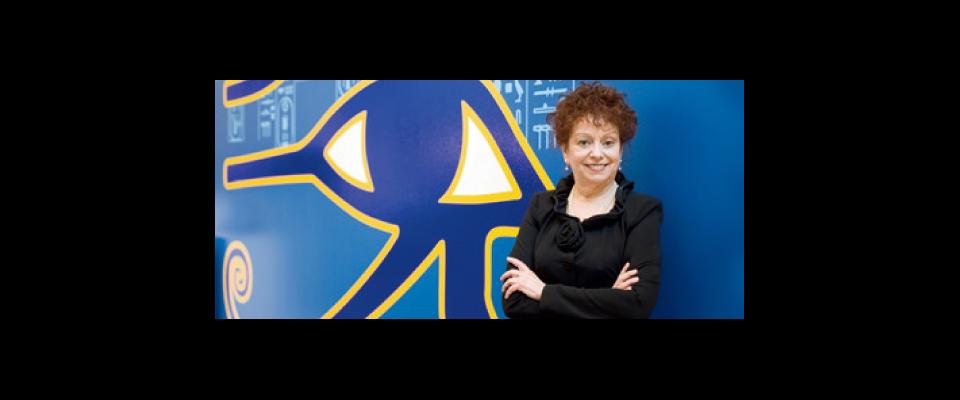After 30 years, Renée Dreyfus welcomes the ‘Boy King’ back to the Bay
Renée Dreyfus stood in a corridor of the Legion of Honor considering an ancient Egyptian idol carved from granodiorite. The figure, which held an ankh and a scepter, represented a deity, but she couldn’t say which one: It was missing its head. What she did know was that the statue was carved for Amenhotep III’s sed-festival, a ceremony celebrating 30 years or so on the throne, when the gods would renew the aging pharaoh’s power.
Thirty years is a significant milestone for Dreyfus, as well. Three decades ago, in 1979, she curated the original Treasures of Tutankhamun exhibit when it came to San Francisco. One of the first so-called blockbuster exhibits, the Treasures brought 1.3 million visitors to the de Young in just four months. Dreyfus was in her 30s at the time—“the boy king and the girl curator,” she jokes now, recalling that early highlight of her tenure. This summer, Tut returned to San Francisco in Tutankhamun and the Golden Age of the Pharaohs, and Renée Dreyfus is once again curating.
Back in 1979, when Steve Martin was doing the Funky Tut on the comedy circuit, Dreyfus didn’t have a Ph.D. She had earned her master’s at Brandeis and intended to get her doctorate there as well but life intervened and she never finished. The Ph.D. remained a goal however, so in 1981, with a full-time job and two kids to raise, she matriculated at Berkeley, eventually earning her doctorate in Near Eastern studies in 2001. Her dissertation topic was Assyrian carved ivories, work that also touched on Egyptian, Phoenician, Near Eastern, and classical artifacts and reflected her interests in the connections among the myriad cultures of the ancient Mediterranean.
Today, Dreyfus is curator of ancient art and interpretation at the Fine Arts Museums of San Francisco, a position that marries her curatorial expertise with her passion for education. “It’s not enough to just collect it and preserve it and make certain people have the chance to see it,” she said, “but that they understand what it is and why it’s important. Why is it in a museum? And how does it relate to other objects in the museum?”
Over the last decade, Dreyfus has orchestrated three major exhibitions dealing with ancient Egypt, beginning with a sampling from the collection of the British Museum in 2002. Then in 2005, she joined forces with fellow Berkeley alumnae Cathy Roehrig, Ph.D. ’90, of the Metropolitan Museum of Art and Berkeley Egyptologist Cathleen Keller, M.A. ’71, Ph.D. ’78, who died in 2008, to illuminate the legacy of Hatshepsut, whom Roehrig calls the greatest female pharaoh in ancient Egypt. Finally, there is the current Tut exhibition.
Before agreeing to host Tutankhamun and the Golden Age of the Pharaohs, Dreyfus demanded certain modifications: improved labels, a modified layout that works better with the DeYoung space, and additional artifacts. Dreyfus feels that the resulting exhibition is more in line with the educational value of the previous two; furthermore, the featured objects are unlikely ever to go on tour again. That’s crucially important to Dreyfus, who believes that direct interaction with artifacts is what makes museum exhibits special. “It’s not looking at slides or PowerPoint; it’s not looking at books,” she says. “You’re confronted by the real object.”
Dreyfus’s own enthusiasm for ancient art was sparked when her parents brought her to museums as a girl, and she’s overjoyed to encounter people who saw Tut in 1979 as children, coming to the current exhibition with kids of their own.
Her career is by no means limited to ancient Egyptian artifacts. Dreyfus’s interpretative role has kept her involved in a wide variety of exhibits, ranging from early Irish treasures to the Muppets. That said, she is already working on a Halloween exhibit called Very Postmortem: Mummies and Medicine. A key part of the exhibit will be the results of a CT scan of one of the museum’s mummies.
One thing is certain, says Dreyfus: Egypt continues to fascinate the public. “People just love it. There’s a mystery about ancient Egypt, there’s an excitement…. More than any other people, they put so many of their resources towards the next world and living eternally and the sheer beauty of the objects.” Objects like the one carved for Amenhotep’s 30th anniversary.
Incidentally, the reign of Amenhotep III falls within the scope of the Tut exhibit, making the piece a perfect complement to the new show. But Dreyfus sees another parallel: “I say that for my 30th anniversary of having worked on the Tut show, I’m renewed.” She laughed and turned toward the ancient Greek vases. “My sed-festival.”





















